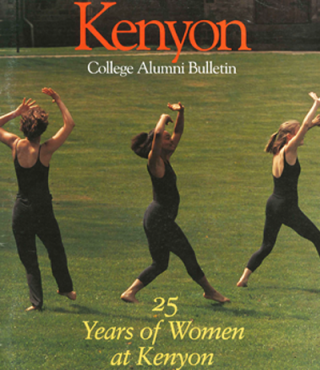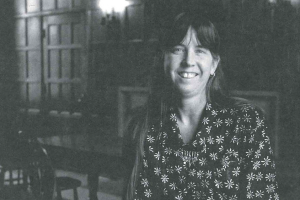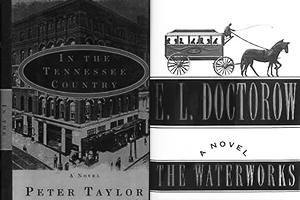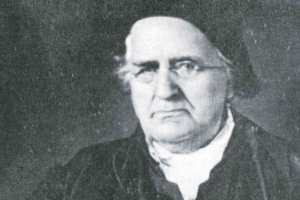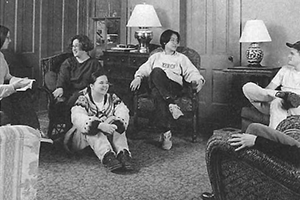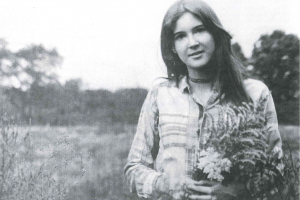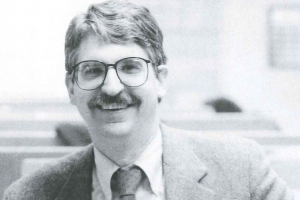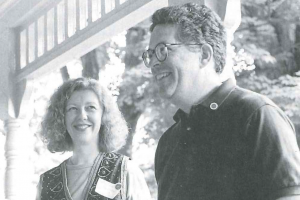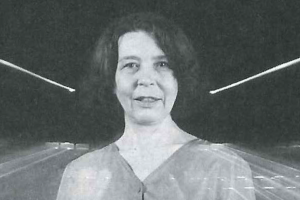Editor's note: The following article is adapted from an address given by Associate Professor of English Adele S. Davidson '75 at Kenyon's annual Founders' Day Convocation and Rite of Matriculation (for the Class of 1998) in Rosse Hall on Oct. 25, 1994.
"I will now describe this place," wrote a students to his father in 1828. The place he describes is home to bears, boars, wolves and "innumerable" rattlesnakes; there are size dead rattlers, he notes, hanging in the room where he drafts his letter. The wilderness and wildlife evoke not fear, however, but a sense of the sublime:
From the top of the college is an extensive view of many miles, but nothing is seen except the almost interminable forests ..., which extend for hundreds of miles every side. The trees are most majestic ... The Bishop shewed me a place in the forest where the church is to be erected. It will be large enough to hold 1,000 persons. A cucumber tree stands where the Communion Table will stand; a sumach tree supplies the place of the future font, and a stately sycamore holds the place of the steep.

How many of us will recognize in that cluster of trees the outline of "this place," Rosse Hall, originally Rosse Chapel, the second College building, named for Lady Jane Rosse of England (pictured left)? We celebrate today the visionary gleam in the eye of the Bishop, the Countess, and the student, who could conjure a college from a lump of trees, on an uninhabited hill-top, an island in an ocean of forest. When he came to the Hill in 1826, Kenyon's first founder slept on the ground, on the grounds of his new college, in a primitive tent of boards and branches. Here, not Mount Vernon, was home.
A student, who was later the first resident of Old Kenyon, wrote, "I spent my first night on College Hill in a cabin of boughs, covered with English blankets, the donation of English liberality." What a contrast between this student's first housing and his last, in a new Old Kenyon, its walls of hewn stone three feet thick, its grandeur worthy of an Oxford quadrangle. To pay for tuition and to help build Old Kenyon, the dormitory's first occupant taught school to children of local settlers. The tuition he charged, $2 per student for three months, payable in corn at 10 cents per bushel, all went to Kenyon. (With more than eighty students, he must have raised more than sixteen hundred bushels of corn.)
We celebrate today the unselfish labors of our first student founders, who hunger of spirit and love of liberal learning led them to cast their lot with a tiny wilderness college. They gave to its future without seeking recompense. At the ceremony that laid the cornerstone of Old Kenyon, the sermon took its preface from Isaiah: "The wilderness and the solitary place shall be glad; and the desert shall rejoice and blossom as the rose."
We honor today friends and founders of the College whose acts of faith and witness have shaped our lovely local landscape. We honors as well the immeasurable minds — Euclid, Newton, Einstein, Freud — who have founded our academic disciplines and thus have given us new voice and vision. We celebrate our Kenyon community of learning and remember that the successes of Robert Lowell '40 encouraged those of his roommate, Peter Taylor '40, and that an English 1-2 class that produced one novelist, Perry C. Lentz '64, also produced another, P.F. Kluge '64. I wish us similar mutual inspiration. Both Lentz and Kluge have dedicated books to their freshman English teacher, Denham Sutcliffe, and I wish to dedicate my talk today to the memory of a cherished College founder, Gerrit Roelofs. Anyone who reads "Alma Mater: A College Homecoming" will know that Kenyon faculty members haunt and hallow the minds of their students through an entire lifetime.

As we celebrate today twenty-five years of women at the College, we honor especially our female founders, women such as Sophia Chase (pictured right), the Bishop's wife, who presided over dining, managed the accounts, and served as Kenyon's first librarian. Today we recognize our partnership with these women in a new, more inclusive College, a Kenyon of men and women, the venture that, next to the Bishop's brilliant divination, has most radically transformed the outlines of Gambier Hill. You, the Class of 1998, are pioneers in coeducation. You are the College's first class with fully coed housing, and you are the first class with a student who can claim both parents as Kenyon alumni. Your beginning augurs well for the future of the College.

Only tow of Kenyon's sixteen presidents have led both male and female students. Our previous president, William G. Caples '30, served as architect of transition; with Provost Bruce Haywood and Dean of Women Doris B. Crozier (pictured left), Caples successfully completed the first phase of bringing women to campus. This blueprint called for two colleges in Gambier: Kenyon College and the Coordinate College for Women at Kenyon College. The first three classes of women were admitted not to Kenyon but to the Coordinate College; only after three pioneering years did Kenyon decide to integrate fully. The last class of women admitted to the Coordinate College — my class — graduated from Kenyon in May 1975.
On October 25, 1975, exactly nineteen years ago today, Philip H. Jordan Jr. was inaugurated as president of the College. You see before you, then, the only president that a fully coeducational Kenyon has ever had, the only president of a College where all the classes have been admitted, not to the women's college, but to Kenyon. As we celebrate President Jordan's anniversary, and the anniversary of women at Kenyon, we are still engaged in a first-generation act of founding.
Twenty-five years ago, the role of women was uncharted, a contested and confused domain. There were four women faculty members. "My Coordinate College Handbook," a different set of rules from those the men received lists the buildings of the women's college: three dormitories, Gund Commons, and a dance studio. It then lists separately all the buildings belonging to Kenyon: every other space on campus. The Coordinate College and the women's dormitories — originally Dorms 1, 2, and 3, now McBride, Mather, and Caples residences — remained nameless for much of this early period. Feminist criticism has argued that women suffer when defined as "a lack, a negation, an absence," and the Coordinate College suffered from its lack of name, the sign of a greater structural deficiency.
The problem was not coeducation, but coordination, separate-but-not-quite equal colleges, two of everything. A dean of women and a dean of Kenyon. Separate male and female "baby books." Separate opening dinners, men in Peirce and women in Gund, where the women were told we could not participate in the Freshman Sing: that was a Kenyon tradition, not a Coordinate College one. We were invited to invent our own traditions or, if we wished, to watch the men sing on the steps of Rosse Hall. The Kenyon catalog announced, "To be part of the creation of a new institution is truly an exhilarating experience," and I must admit I found it so, especially in the College's classrooms.
However, many women found the creation of a women's college in Gambier a little too exhilarating, and about a quarter of my class transferred. We remember those women today as lost founders of Kenyon. Those of us who stayed, like the students of Philander Chase, traced patterns in majestic trees and sought in imagined outlines the promise of a more congenial future.
As we honor the founders whose names emblazon the Matriculation Book, we must remember as well those whose names do not appear. No signatures of women occur until 1972; originally, members of the Coordinate College were not allowed to matriculate. That was a Kenyon tradition, not a Coordinate College one. As a freshman I was not allowed to sign; in my sophomore year, however, when the Coordinate College was dissolved and integrated into Kenyon, we finally achieved that privilege. To me the moment was, as Shakespeare says, "the more delayed, delighted." However, I have friends from the early classes of women who still have not signed; they want no part of a ritual that excluded them. These founders' names, unsigned, are lost to the matriculation book.

The poet Adrienne Rich has asked men and women to "re-vision" the past, to see "how the very act of naming has been till now a male prerogative, and how we can begin to see and name-and therefore live-afresh." As Kenyon "revisions" its own past, we find many women founders. Margaret Kenyon, the daughter of our founding Lord Kenyon, kept an "Ohio garden" all her life, its first seeds brought to her by Philander Chase, its log cabin and sloping hill imaging faith in the seeds the Bishop took back to plant on this Ohio hill. One group of English ladies raised funds for the Bishop to buy a printing press; they are the ancestors of women who, in recent times, have promoted publishing and poetry at the College, especially two presidents' wives, Roberta Teale Swartz Chalmers (pictured left), who conceived the idea of he Kenyon Review, and Sheila Jordan, whose poetry and advocacy of poetry have inspired nineteen generations at the College. Our faculty spouses and office-support staffs, two groups historically composed of women, deserve special recognition today for their often anonymous and unacknowledged aid to Kenyon.
The earliest men of the College found inspiration in female writers. In 1839, one student noted in his journal:
Read "Helen" by Maria Edgeworth but became so excited by the character of Helen that I was obliged to throw it down — I took it up again but with no better success — Novels generally are very exciting to my feelings ...
In March of 1852, a student from Pittsburgh, Pennsylvania, gave an oration on Hannah More, the early feminist and Kenyon founder. This progressive speech was followed by a debate on the topic: Should Roman Catholics be allowed to vote? George Eliot reminds us that "The blessed work of carrying the world forward happily does not wait to be done by perfect men."
The first quarter century of the College, and the first quarter century of women at Kenyon, have produced a college that reconciles oxymoronic opposites. The Bishop's college created American Anglophiles, a pioneer gentry, men who practiced a wilderness civility and an ethos of practical idealism. The history of women at Kenyon finds similar paradoxes: innovative tradition, respectful skepticism, teacher learners, a feminist male domain. These fruitful tensions have encouraged creative and adaptive thinking in both periods of the College's history. The students from the early days of women at Kenyon-this means you-will doubtless distinguish themselves as did our earliest alumni. Graduates from our first quarter century include Abraham Lincoln's campaign manager (David Davis), his secretary of war (Edwin Stanton), and his secretary of the treasury (Salmon Chase). Lincoln relied on these men in his efforts to preserve the Union, because the College's alumni shared with him an intellectual and cultural affinity: a firsthand knowledge of life on the frontier and of virtues fostered in civic isolation.
In the early days of Kenyon, Rutherford B. Hayes gave his first public address ever-here in Rosse Chapel, January 20, 1842. Like President Clinton, Hayes was a posthumous child, and, lacking a father, owed much to the support of his mother and sister. Here Hayes describes a return from spring break:
Dear Sister: — Two stages containing twenty-two souls left Columbus one very rainy day ... bound for Gambier, a place famous for being the seat of a literary institution, commonly known as the "Star of the West." ... When the conversation turned [to] the "six-mile woods " [between Mount Vernon and Gambier] ... it was quietly suggested that we should probably have to go through them after dark, ... "and take it afoot in the rain and mud." ... We got to Mount Vernon about 3:00 [a.m.] The kingbolt came out about one [a.m.] and left us in the mud. Owl Creek was impassable. We carried twenty-two trunks over a narrow footbridge in the darkest night.
In a later memoir, Hayes wrote of his sister, Fanny, that "when I began to prepare for college and recited Latin and Greek ... , [Fanny] took up the same studies and recited to me after my return from recitation ... In these studies she was very successful and used often to wish that she was a boy so she might go with me to college."
As she helped her brother prepare for college, Fanny Hayes indirectly helped Kenyon to join the elite group of colleges that have produced a United States president. Hayes's sister gives a local analogue of a character from a famous essay by Virginia Woolf, "Shakespeare's Sister," a powerful meditation on the losses that accrue from neglecting to educate women. Woolf's essay expresses anger but also articulates hope:
[Shakespeare's sister,] this poet who never wrote a word ... still lives. She lives in you and me ... for great poets do not die; they are continuing presences; they need only the opportunity to walk among us in the flesh. This opportunity, as I think, it is now coming within your power to give her.
I cannot think of poetry in Rosse Hall without recalling one of my most memorable moments here: an electrifying reading given by Robert Lowell. A life of hardship showed on Lowell's face that night. He had been institutionalized for manic depression and jailed as a conscientious objector. When a cellmate said to him, "I'm in for killing; what are you in for?" Lowell replied, "I'm in for refusing to kill." But that night was a time of triumph and delight. Kenyon welcomed the return of its own, its poet laureate: in a packed Rosse Hall, then an old gymnasium with a flat wooden floor, students literally dangled from the rafters to see and hear the son of Ransom.
You may remember how Lowell happened to come to Kenyon as a student. He showed up one day at the door of Allen Tate in Tennessee, asking for a place to stay and a chance to study poetry with Tate and his colleague, John Crowe Ransom. Tate, a Southern gentleman, replied that his house was full of guests and add, jokingly, "Any new guest would have to pitch a tent on the lawn." Lowell, of course, went out, bought a tent, ant pitched it in the Tates' back yard.
Like Bishop Chase and his early Kenyon students, Lowell pitched his tent where he set his heart; he trusted an inner intuition and built his future life in poetry. Ransom, his remarkable mentor, took Lowell with him to Kenyon, housed Lowell in the Ransom home, published Lowell's poetry, and above all gave him strength to sustain his gift. Lowell said , "He kept me from breaking myself."
I wish that you, the Class of 1998 — whatever your inner vision may be — will find the founders here to help you pitch your tent, and that, after graduating, you will return to share with us the gifts you have developed. I wish you, in your time at Kenyon, intellectual intimacy and intellectual elation.

Adele Davidson '75, a summa cum laude Kenyon English major, joined the faculty in 1985 after earning a doctorate at the University of Virginia and teaching at Bowdoin College.


